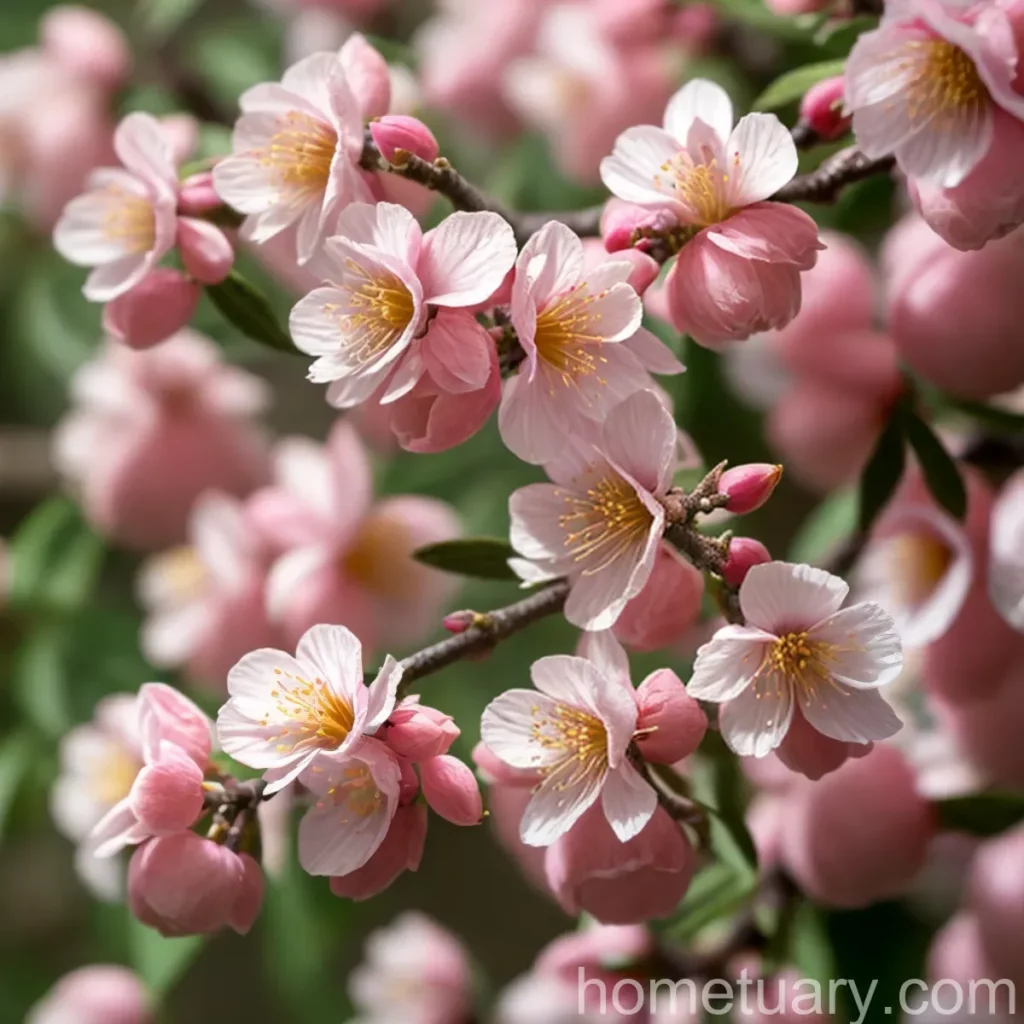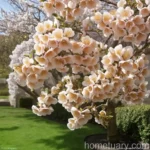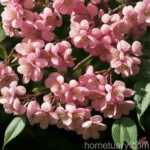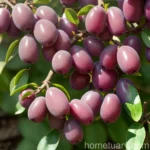The Beautiful and Versatile Dwarf Flowering Almond (Prunus glandulosa ‘Sinensis’)
Plants have always held a special place in human society, not just for their ecological importance but also for their aesthetic and cultural value. One such plant that has gained popularity for its ornamental beauty and versatility is the dwarf flowering almond (Prunus glandulosa ‘Sinensis’). This charming plant, also known as the dwarf almond tree, has captured the hearts of many gardeners and horticulturists due to its delicate blossoms, compact size, and ease of care. In this comprehensive guide, we will explore the various aspects of the dwarf flowering almond, including its cultural requirements, uses, propagation methods, common diseases, and much more.
What is the Dwarf Flowering Almond (Prunus glandulosa ‘Sinensis’)?
The dwarf flowering almond (Prunus glandulosa ‘Sinensis’) is a deciduous shrub that belongs to the Rosaceae family, specifically the Prunus genus. It is native to Asia, particularly China, and is renowned for its stunning display of early spring blossoms. This plant is characterized by its compact size, making it an excellent choice for small gardens, urban landscapes, and containers.
Key Takeaways – Dwarf Flowering Almond (Prunus glandulosa ‘Sinensis’)
Before delving into the specifics of cultivation and care, let’s highlight the key takeaways related to the dwarf flowering almond:
- Common Name: Dwarf Flowering Almond
- Scientific Name: Prunus glandulosa ‘Sinensis’
- Family: Rosaceae
- Genus: Prunus
- Native Habitat: China
- Characteristics: Compact size, early spring blossoms
- Uses: Ornamental purposes, small hedges, containers
- Versatility: Suitable for various soil types and climates
Now that we have a brief overview of this charming plant, let’s dive into its cultural requirements and the best practices for nurturing it to its full potential.
Culture of Dwarf Flowering Almond (Prunus glandulosa ‘Sinensis’)
Cultivating the dwarf flowering almond requires a good understanding of its specific cultural requirements. From water and sunlight to soil and fertilizer needs, each aspect plays a crucial role in ensuring the plant’s health and vibrancy.
Water
Proper watering is essential for the health and vigor of the dwarf flowering almond. Here are some guidelines to keep in mind:
- Young Plants: Newly planted or young plants require regular watering to establish strong root systems. Provide water when the top inch of soil feels dry, usually every 7-10 days depending on the local climate and soil conditions.
- Mature Plants: Once established, the dwarf flowering almond is relatively drought-tolerant. Water mature plants deeply, especially during dry spells, but ensure that the soil is well-draining to prevent waterlogging, which can lead to root rot.
- Moisture Preferences: While the plant can tolerate dry conditions, it performs best in slightly moist, well-drained soil. Avoid consistently wet or waterlogged soil.
Sunlight
Proper sunlight exposure is crucial for encouraging healthy growth and abundant blossoms in the dwarf flowering almond:
- Full Sun: This plant thrives in full sunlight, preferring at least 6-8 hours of direct sun each day. Ensure that the chosen planting location receives ample sunlight to promote optimal flowering.
- Shade Tolerance: While the dwarf flowering almond prefers full sun, it can tolerate partial shade. However, reduced sunlight may lead to decreased flowering and overall vigor.
Fertilizer
Feeding the dwarf flowering almond with the right nutrients supports its growth and flowering potential:
- Nutrient Needs: Use a balanced, slow-release fertilizer formulated for flowering shrubs in early spring before the growing season begins. Follow the manufacturer’s recommendations for application rates and frequency.
- Organic Matter: Incorporating organic matter, such as compost, into the soil during planting can provide long-term benefits by improving soil structure and fertility.
Soil
Understanding the ideal soil conditions for the dwarf flowering almond is essential for promoting its health and longevity:
- Texture: The plant thrives in well-drained, loamy soil with a slightly acidic to neutral pH (pH 6.0-7.0).
- Soil Amendments: If the native soil is heavy clay or excessively sandy, amending it with organic matter can improve drainage and nutrient retention.
- Container Considerations: When cultivating the dwarf flowering almond in containers, use a high-quality potting mix with good drainage to mimic its preferred soil conditions.
Pruning and Propagation
Pruning and propagation are important aspects of managing and expanding the dwarf flowering almond population. Proper techniques can enhance its appearance and rejuvenate older plants.
Pruning
Pruning the dwarf flowering almond serves several purposes, including shaping the plant, removing dead wood, and stimulating new growth:
- Timing: Prune the plant immediately after flowering to avoid cutting off next year’s flower buds. Early spring pruning, before new growth emerges, is ideal.
- Tools: Use sharp, clean pruning shears to make precise cuts and minimize the risk of damage or disease transmission.
- Pruning Goals: Remove dead, damaged, or crossing branches and shape the plant to maintain a compact, balanced form. Avoid excessive pruning, as this can reduce flowering the following season.
Propagation
Expanding your collection of dwarf flowering almonds, or sharing the plant with fellow enthusiasts, can be achieved through propagation methods such as:
- Softwood Cuttings: Take 4-6 inch cuttings from the current season’s growth in early summer. Dip the cut ends in rooting hormone, and place the cuttings in a well-draining rooting medium. Provide consistent moisture and warmth to encourage root development.
- Divisions: Divide established plants in early spring before new growth begins by carefully separating the root mass into individual sections. Replant the divisions in prepared soil and water deeply to encourage establishment.
Both pruning and propagation are important skills to master for those looking to maintain and expand their collection of dwarf flowering almonds.
Uses of Dwarf Flowering Almond (Prunus glandulosa ‘Sinensis’)
The dwarf flowering almond is highly valued for its ornamental beauty and versatile uses in various landscape settings. Here are some common uses of this charming plant:
- Garden Specimen: The compact size and early spring blossoms make the dwarf flowering almond an excellent choice as a focal point in small gardens and landscapes.
- Hedging: When planted in multiples, the dwarf flowering almond can be used to create low hedges or edging along garden beds, walkways, or borders.
- Container Planting: Its adaptability to container culture makes it suitable for patio, balcony, or small-space gardening, adding a touch of elegance and color to urban settings.
- Mixed Borders: Incorporate the dwarf flowering almond into mixed perennial or shrub borders to provide seasonal interest and a burst of color in early spring.
The plant’s versatility and aesthetic appeal make it a valuable addition to any garden or landscape design.
Popularity of Dwarf Flowering Almond (Prunus glandulosa ‘Sinensis’)
The popularity of the dwarf flowering almond has steadily increased due to its many attractive features. Gardeners, horticulturists, and landscape designers are drawn to its ornamental qualities and ease of care.
Ornamental Value
The exquisite, rose-like blossoms of the dwarf flowering almond make it a coveted choice for ornamental plantings. The delicate pink or white flowers, often borne in clusters, create a picturesque scene in early spring.
Size and Adaptability
Its compact size and adaptability to various growing conditions, including urban environments and container culture, further contribute to its widespread appeal.
Seasonal Interest
The early spring blooms provide a welcome burst of color and fragrance after the winter season, adding a sense of renewal and vitality to the landscape.
Common Diseases and Pest Management
While the dwarf flowering almond is generally resilient, it can be susceptible to certain diseases and pest infestations. Understanding these potential challenges is crucial for proactive management and maintaining plant health.
Common Diseases
- Powdery Mildew: This fungal disease presents as a powdery white coating on the leaves, often due to poor air circulation or high humidity. Use fungicidal treatments as a preventative measure and maintain good airflow around the plant.
- Leaf Spot: Circular or irregular leaf spots may indicate fungal or bacterial pathogens. Remove and destroy affected foliage and avoid overhead watering to reduce moisture on the leaves.
- Root Rot: Overly wet or poorly drained soil can lead to root rot, causing wilting, yellowing leaves, and overall decline. Improve soil drainage and avoid overwatering to mitigate this issue.
Pest Management
- Aphids: These small, sap-sucking insects can cause distortion of new growth and excrete honeydew, leading to sooty mold development. Use insecticidal soap or neem oil to control aphid populations.
- Scale Insects: Scale insects can infest the stems and leaves of the dwarf flowering almond, causing yellowing and weakening of the plant. Prune and dispose of heavily infested branches and consider using horticultural oil for effective control.
Vigilance, good cultural practices, and prompt intervention are essential for preventing and managing diseases and pests that may affect the dwarf flowering almond.
Botanist’s Tips for Growing Dwarf Flowering Almond (Prunus glandulosa ‘Sinensis’)
To achieve the best results when growing the dwarf flowering almond, consider the following tips from experienced botanists and horticultural experts:
- Site Selection: Choose a well-drained location with ample sunlight for optimal flowering and plant health.
- Mulching: Apply a layer of organic mulch around the base of the plant to conserve soil moisture and suppress weed growth.
- Maintenance Pruning: Regularly inspect the plant for dead or damaged branches and perform light pruning as needed to maintain its shape and vigor.
- Soil Amendment: Incorporate organic matter into the soil during planting to enhance fertility and improve soil structure.
Adhering to these tips can contribute significantly to the success of cultivating the dwarf flowering almond and enjoying its charming blossoms.
Fun Facts About Dwarf Flowering Almond (Prunus glandulosa ‘Sinensis’)
Here are some delightful and intriguing facts about the dwarf flowering almond that add to its allure and appeal:
- The plant’s delicate blossoms resemble miniature roses, creating a whimsical and romantic appearance in the landscape.
- Dwarf flowering almonds are often used in Japanese-style gardens for their symbolic and aesthetic significance during the spring season.
- Despite its small stature, the plant can attract pollinators, including bees and butterflies, with its fragrant and nectar-rich flowers.
- In Chinese culture, the almond tree is associated with qualities such as hope, rejuvenation, and endurance, making it a valued symbol in various traditions and celebrations.
Links to External Resources
For further information and resources on the dwarf flowering almond, consider exploring the following links:
- Royal Horticultural Society – Prunus glandulosa
- University of Florida IFAS Extension – Flowering Almond
- Missouri Botanical Garden – Prunus glandulosa
Conclusion
The dwarf flowering almond (Prunus glandulosa ‘Sinensis’) is a captivating and versatile plant that enriches gardens and landscapes with its early spring blossoms and compact form. Its adaptability to various growing conditions, including container culture, makes it an attractive choice for both novice and experienced gardeners. By understanding and implementing the proper cultural practices, such as watering, sunlight exposure, and disease management, enthusiasts can enjoy the beauty and charm of this ornamental shrub for years to come. Whether used as a standalone specimen, a low hedge, or a container plant, the dwarf flowering almond brings an enchanting touch to outdoor spaces and continues to captivate plant lovers around the world.















